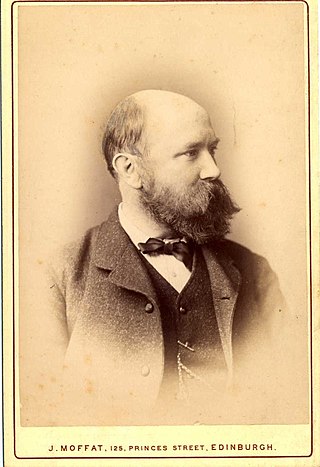Related Research Articles

Dame Elizabeth Violet Blackadder, Mrs Houston, was a Scottish painter and printmaker. She was the first woman to be elected to both the Royal Scottish Academy and the Royal Academy of Arts.

William McTaggart was a Scottish landscape and marine painter who was influenced by Impressionism.
Mildred Anne Butler was an Irish artist, who worked in watercolour and oil of landscape, genre and animal subjects. Butler was born and spent most of her life in Kilmurry, Thomastown, County Kilkenny and was associated with the Newlyn School of painters.

John Reinhard Weguelin was an English painter and illustrator, active from 1877 to after 1910. He specialized in figurative paintings with lush backgrounds, typically landscapes or garden scenes. Weguelin emulated the neo-classical style of Edward Poynter and Lawrence Alma-Tadema, painting subjects inspired by classical antiquity and mythology. He depicted scenes of everyday life in ancient Greece and Rome, as well as mythological subjects, with an emphasis on pastoral scenes. Weguelin also drew on folklore for inspiration, and painted numerous images of nymphs and mermaids.

Mary Margaret Cameron was a Scottish artist, renowned for her depictions of everyday Spanish life. She exhibited 54 works at the Royal Scottish Academy between 1886 and 1919.

Madeline Francis Jane Marrable, née Cockburn was a prolific London based watercolourist and oil painter specialising in landscapes with a preference for mountains and snowscapes. She traveled widely to places including Austria, France, Italy, Ireland, Switzerland and Venice. Noted works include: Ancient Cedars at Ankerwycke, Staines, Moonlight at Chiavenna and The Diligence Halting. She exhibited both in Britain and abroad, including at the Royal Academy between 1864 and 1903. She exhibited her work at the Palace of Fine Arts and The Woman's Building at the 1893 World's Columbian Exposition in Chicago, Illinois. Her painting Isola Bella Lago Maggiore was included in the 1905 book Women Painters of the World. In 1886, Marrable was elected as the first President of the Society of Lady Artists (SLA), formerly the Society of Female Artists (SFA) and since 1899 is now known as the Society of Women Artists (SWA), she retired from the presidency in 1912.

Eloise Harriet Stannard (1829–1915) was a British 19th century painter known for her still life work. She was one of only two notable women artists associated with the Norwich School of painters, Britain's first provincial art movement.
Minnie Smythe (1872–1955) was a British landscape watercolourist. Her paintings often depicted the figures and countryside of the Pas-de-Calais region of France.
John Blair was a Scottish painter, predominantly of watercolour landscapes. Of humble beginnings in Berwickshire, he moved to Edinburgh to study and spent the rest of his life there. His paintings mainly reflect the landscapes around him, both of urban settings and also of the castles, sea and lochs of the Borders, although he also painted figures and still lifes. As well as his original work, his paintings were viewed by a wide audience in the form of picture postcards, book endpapers and illustrations.
William Walker Morris was a British nineteenth-century painter of the Victorian period who worked in Greenwich and Deptford, England, and was known particularly for his bucolic genre oil paintings depicting sporting and homestead life, with an emphasis on hunting dogs. His works draw upon the imagery of life in the Scottish Highlands. He died at some time from 1867 to 1881.
David Shanks Ewart was a Scottish painter, born in Glasgow. He went to the Glasgow School of Art just after the First World War. He won the Guthrie Award in 1926 with his work The Toilers.
Laelia Armine Cockburn was a Scottish painter, born in Glencairn, Dumfries and Galloway. She won the Guthrie Award in 1925 with her work A Rough Lot For Sale.
Gordon Stewart Cameron was a Scottish painter, born in Aberdeen, Scotland. He won the Guthrie Award in 1944 with his work, the painting Boy With Apple.
William Drummond Bone was a Scottish painter, born in Ayr. He won the Guthrie Award in 1939 with his work, the oil painting Leisure.
Gertrude Annie Lauder was an English-born Scottish painter, born in Camden Town, England. She moved to Glasgow, Scotland: where she joined the Glasgow Society of Lady Artists; married the artist Charles James Lauder; and exhibited in the Royal Scottish Academy. On her death she left legacies to the Scottish Artists Benevolent Association, gave a fund to the Glasgow Art Club and left a fund to the Glasgow Society of Lady Artists to encourage art by women. The Lauder Prize, named for the best work adjudged in the Glasgow Society of Lady Artists annual exhibition, is named after her.
Helen Adelaide Lamb was a Scottish artist known for her embroidery and paintings. She won the Lauder Prize in 1924, 1931 and 1953.
Laura Loudon was a Scottish painter. She won the Lauder Prize in 1939.
Stirling Art School was an independent art college in Stirling, Scotland, providing tertiary education in art and design.
John Daniel Revel was an artist; and former Director of the Glasgow School of Art. He took the post of Director in 1925.
James Arroll was a Scottish painter. He is known for his landscapes and west coast scenes.
References
- ↑ The Dictionary of Scottish Painters. 1600 to the present. Paul Harris and Julian Halsby. Canongate Publishing. 1990.
- ↑ "Stirling Observer". 3 July 1862 – via British Newspaper Archive.
- ↑ "Stirling Observer". 1 June 1865 – via British Newspaper Archive.
- 1 2 3 4 5 The Royal Scottish Academy Exhibitors 1826 - 1990. Charles Baile de Laperriere. Hilmarton Manor Press. 1991.
- 1 2 "Dundee Courier". 17 December 1904 – via British Newspaper Archive.
- ↑ "Sold at Auction: Catherine Monteath, Catherine Monteath (19th Century) British. "Apple".